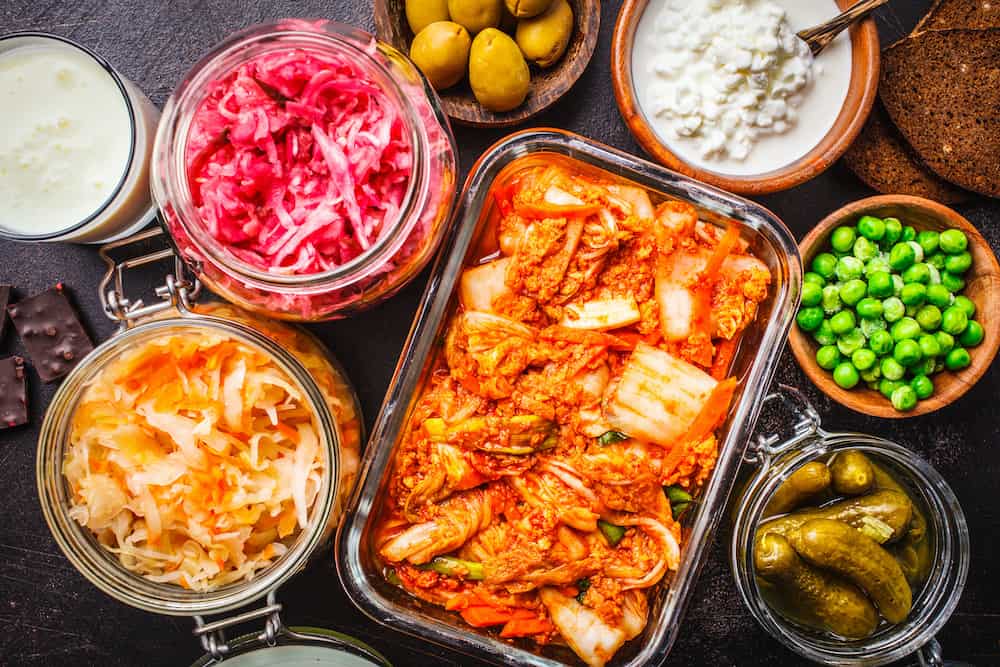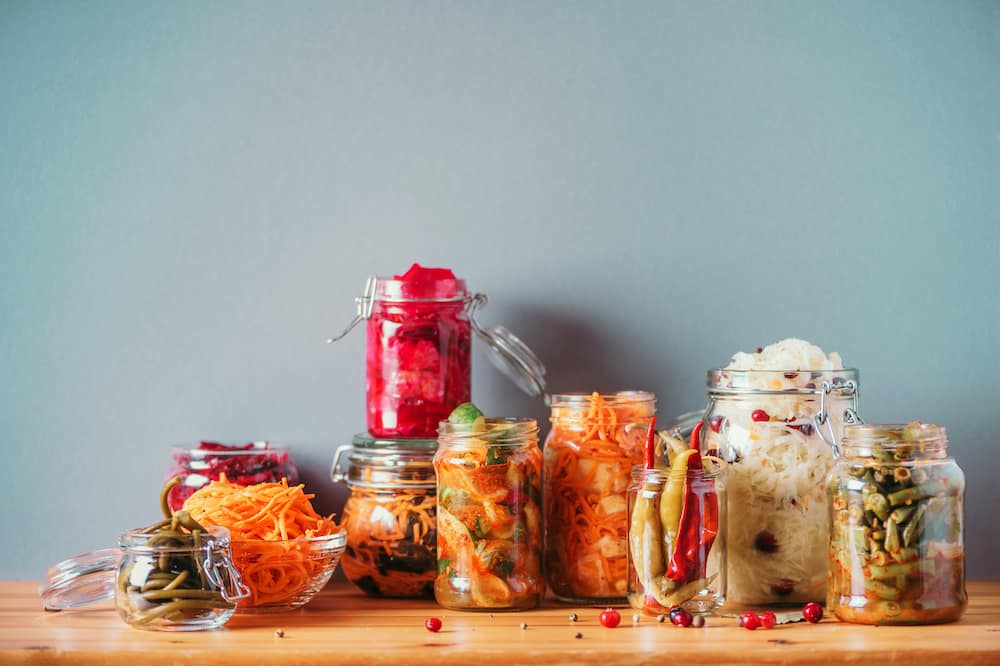Depending on what types of food you like, you might have tried fermented foods, but you might not have eaten anything like it before. Here I explain examples of fermented foods.
Fermented foods are often included in Asian meals as side dishes to enhance the main dish’s flavor. Examples are kimchi, natto, and umeboshi. In central and eastern Europe, sauerkraut is a staple.
You can find fermented foods in grocery stores — in the refrigerated section — and restaurants all around the world.
To better understand fermented foods and beverages, I explain what they are, what fermented means, and more.
List of Fermented Foods
Here is a list of fermented foods. You can use it to look for pre-made fermented foods in the grocery store, order in restaurants, or to learn what you can make on your own.
Kimchi
Kimchi is a popular Korean side dish. You may find other restaurants serve it as well. It is usually made using cabbage, but you can also find ones made of radishes and other vegetables.
Besides being a side dish, you can also use kimchi in salads and sandwiches. You can also mix kimchi with eggs to make an omelet, use it as a fried rice ingredient, or simply add it to your soup for spiciness.
Kimchi is also a popular option for many people because it is a simple dish to make.
Tempeh
As a form of plant-based or vegetarian protein, tempeh is somewhat similar to tofu. The difference is that it is made through the fermentation process and has a nuttier flavor and firmer texture than tofu.
You can bake, steam, or saute tempeh, and then consume it as is or use it as a dish ingredient.
Unpasteurized sauerkraut
Sauerkraut is a fermented food people use commonly as a condiment. You can also use this as a topping for a casserole, sandwich, or inside a stew.
This food is similar to kimchi since it is made with shredded cabbage, but fermented with lactic acid bacteria that changes the taste a bit.
It is also a great option to put on hot dogs since it tends to have a somewhat similar or complementary taste to mustard.
Yogurt
Yogurt is one fermented food you may have had before, even if you haven’t tried any of the other items on the list. It is a staple of the American diet and often comes in different flavors, including fruit, usually to make it taste more appealing.
It’s made from adding bacteria to milk, which then turns the milk sugar, lactose, into lactic acid. This is what makes the milk thick and gives yogurt its tangy taste.
Kombucha
Eating fermented foods is a unique experience. The taste of the sour flavor can be unusual to some people. They also often have a bubbling effect on the tongue as you eat them.
As such, fermented food is not to everyone’s taste. So, if you want to find another way to get fermented items into your diet, a drink is the best option.
A classic fermented drink called kombucha is a great-tasting option. Kombucha is an effervescent black or green tea fermented and flavored with fruit or herbs. You can find it in grocery stores, convenience stores, and more in many flavor combinations. It often comes with a bit of a tangy flavor that is nicely offset with the fruits’ sweet flavors.
Miso
Miso is fermented soybean paste. The miso itself is a type of paste made out of soybeans, rice, and barley. It adds a nice salty and savory flavor to the soup.
You can find miso soup as an appetizer in Japanese or Vietnamese cuisines. This light and refreshing soup contains vegetable broth, miso, carrots, water chestnuts, and onions.
You can also use this fermented miso paste in other dishes like salads, meat, or seafood marinades.
Kefir
Kefir is a cultured dairy product. Think of it as having a similar taste and texture as yogurt. It is a drink made by adding kefir grains, which is a mixture of bacteria and yeasts, to regular milk.
As a liquid substance, you can drink it on its own, blend it into a fruit and veggie smoothie, or even cook with it.
Some varieties of cheese
Brie, gouda, cheddar, Swiss cheese, and other types of cheese undergo fermentation. If a cheese is fresh, spreadable, and white, it’s likely not fermented. These include ricotta, goat cheese, and cream cheese.
Sourdough bread
Made by fermenting the dough, sourdough bread is known for its tangy flavor.
Beer and wine
Alcoholic beverages created through the fermentation of grains or grapes.
Fermented milk products
Besides yogurt, products like kefir and certain traditional fermented milks.
Fermented soy products
In addition to miso and tempeh, products like natto and soy sauce are examples of fermented foods.
What Are Fermented Foods
Fermented foods and beverages have a distinctive appearance, aroma, taste, and texture. Some reasons people ferment foods are to enhance flavor, preserve foods, for traditions, and more.
By definition, fermented foods have undergone fermentation and controlled microbial growth. It’s a process in which microorganisms — examples are bacteria and yeast — work to break down food components into other products. This anaerobic process breaks it down to gases, alcohol, and organic acids.
Pickled vs Fermented Foods
Some people assume that pickled and fermented foods are the same, but they’re not. Pickled food is preserved in an acidic liquid, usually vinegar, which is a fermentation product.
The difference is that the main ingredient in pickling techniques isn’t fermented.
Fermentation Process
When it comes to understanding what fermented foods are and answering what does fermented mean, we must understand the process of fermentation.
The fermentation technique has been around for centuries but was initially used to preserve foods and beverages when refrigeration hadn’t been discovered yet.
Generally, fermentation is when an organic compound goes through chemical changes with effervescence.
The process changes the compound’s chemical breakdown and makes the food taste different from its original state.
When it comes to beverage and food fermenting, it means that the carbohydrates are converted to alcohol or safe acid by way of bacteria or yeast under certain anaerobic conditions.
It is done on purpose for the desired effect in the ingredient such as post-harvest preservation and more.
Although it is a process that might seem complicated, with proper techniques, you can safely ferment food at home.
Making your own fermented food at home is doable. You only need a few and simple ingredients. Vegetables such as beetroot, cabbage, carrots, turnip, and radish are the easiest to ferment.
That is because they already have bacteria living on their surfaces that can do the fermenting for you.
Make sure that you also use organic and fresh produce. I also suggest adding prebiotic-rich or fiber-rich ingredients like asparagus, artichokes, and onions for more flavor.
Keep in mind that food can also ferment by accident with the presence of environmental bacteria or yeast. However, that is not the same process as foods that you try to ferment.
Also, since food fermenting and fermented foods and beverages are becoming more and more popular, you can already find a lot of commercially available fermented products.

Fermented Foods and Beverages
If you didn’t know what fermented foods and beverages were, how they’re produced, what items to purchase or consider, you now have the essential information about these tasteful foods.
With a variety of options to choose from, you can have all different kinds of meals each day and create a wider palate.
It’s a great way to preserve and store food long term.
There are many ways to incorporate them. Some ideas:
- Using kimchi as a side dish
- Putting sauerkraut in your casserole
- Adding miso to soup
- Drinking kombucha
- Eating yogurt as a dessert
There are lots of ways to enjoy fermented foods and make your meals more exciting.
Learn more about preserving food:
References:

